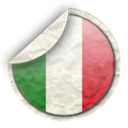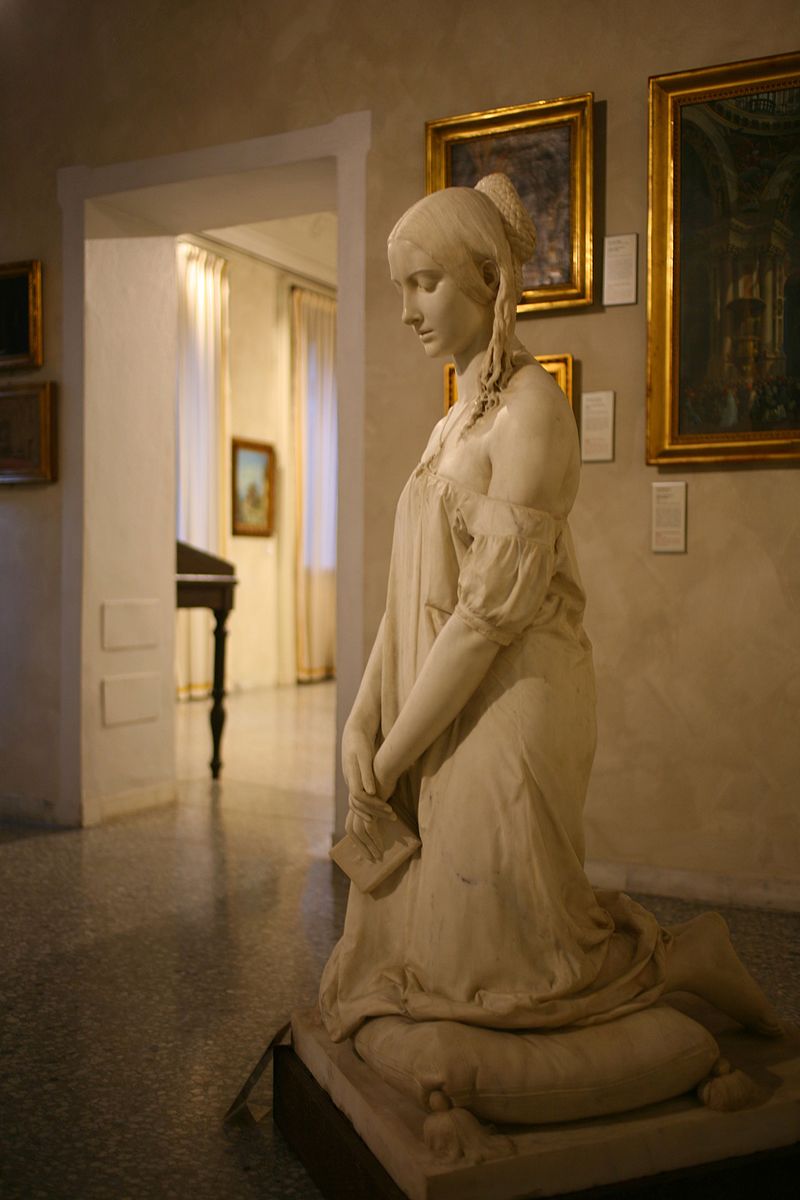 La preghiera del Mattino - Palazzo Morando
La preghiera del Mattino - Palazzo Morando
Palazzo Morando è uno storico palazzo della città di Milano, sito in Via Sant'Andrea, 6, oggi sede del Museo di Milano e della collezione Costume Moda Immagine.
Due distinti percorsi espositivi caratterizzano le sale del settecentesco Palazzo Morando Attendolo Bolognini.
Al primo piano è attualmente ospitata la Pinacoteca: una collezione di dipinti, sculture, stampe che ha avuto origine nel 1934 dall'acquisizione da parte del Comune della collezione di Luigi Beretta e testimonia l'evoluzione urbanistica e sociale di Milano tra la seconda metà del XVII e i primi anni del XIX secolo; negli ambienti attigui sono state riallestite le sale di rappresentanza della casa nobiliare, un percorso suggestivo che documenta in modo esemplare il gusto settecentesco per l'arredo domestico, attraverso un nucleo di decorazioni, mobili e oggettistica recentemente ricomposto nella sua fisionomia originaria con una capillare attività di recupero di un patrimonio nel tempo disperso in diversi depositi esterni al palazzo.
Nel gennaio del 2010 ha visto la luce il nuovo allestimento di Palazzo Morando finalizzato a dare nuova visibilità allo straordinario patrimonio artistico del Museo di Milano e al patrimonio storico delle Raccolte d'Arti Applicate che costituiscono un nucleo portante delle collezioni storiche e artistiche comunali. Gli interventi eseguiti hanno infatti valorizzato, oltre che il patrimonio tessile delle Raccolte Storiche anche le collezioni di abiti, accessori e uniformi conservati nei depositi delle Raccolte d'Arti Applicate del Castello Sforzesco che in questi ambienti hanno trovato la loro idonea sistemazione.
Dal 1995, la volontà di documentare gli aspetti salienti e i protagonisti della vita culturale milanese tra il XVIII e il XIX secolo, integrando così il valore documentario delle collezioni, ha guidato l'organizzazione di alcune rassegne fondamentali, da "Pietro Verri e la Milano dei Lumi", dedicata ai fratelli Verri, a "Oh giornate del nostro riscatto. Milano dalla Restaurazione alle Cinque Giornate", fino a "La Milano del Giovin Signore. Le Arti nel Settecento di Parini" e "I volti di Carlo Cattaneo 1801-1869. Un grande italiano del Risorgimento".
Gli ambienti di maggiore interesse artistico del palazzo sono:
- lo scalone monumentale, a doppia rampa, con la caratteristica balaustra a volute Rococò.
- la Galleria Cinese, esposizione delle porcellane e delle ceramiche cinesi della collezione Morando.
- la Sala dell'Olimpo, la cui decorazione, attribuita a Giovanni Antonio Cucchi, commemora le nozze tra Giovanni Villa e Maria Pusterla celebrate nel 1762.
- Il Salottino Dorato
- la sala Egizia, dal pavimento a mosaico a motivi egizi e classicheggianti
- la sala d'Ercole, dall'affresco della volta realizzata dal pittore Giovan Battista Ronchelli
- la sala Dhò, precedentemente camera da letto ai tempi dei Villa
- la galleria dei busti
- La quadreria settecentesca
Accesso al Museo
Il museo rimane chiuso per riposo settimanale ogni lunedì. Resta aperto tutti gli altri giorni dell’anno esclusi il 15 agosto, il 25 e 26 dicembre e il 1 gennaio.
Orario: dalle 9.00 alle 13.00 - dalle ore 14.00 alle 17.30
chiusura biglietteria: ore 16.30
ultimo ingresso mezz'ora prima dell'orario di chiusura
apertura straordinaria su richiesta per gruppi
Curiosità
La preghiera del mattino è un'opera scultorea giovanile realizzata in marmo dal pittore svizzero Vincenzo Vela nel 1846.
La scultura colpiva per il suo spiccato realismo, tanto che nel 1862 il critico Paolo Müntz la descriveva con queste parole: «La Preghiera del mattino è un'opera nella quale la realtà, forse, è cercata troppo da vicino. È una statua della giovinezza dell'autore, che porta la data del 1846. L'artista di già troppo preoccupato del vero, si è compiaciuto a tradurlo nei suoi minimi dettagli, e andò fino ad indicare la pressione di un cordone troppo serrato sul seno mezzo nudo della giovinetta. Del resto nell'insieme è un'opera esatta, un'opera ben fatta; ma di un sentimento poco elevato»
Curiosità #2
Nel palazzo dove è posizionata la cache (numero civico 19) è presente ancora la vecchia numerazione Austriaca (808)
Il cache
E' un semplice tubetto nella grata a pochi metri dall'ingresso del museo.
Massima attenzione perchè la strada normalmente è invasa da fastidiosissimi babbani. Allacciarsi le scarpe (ovviamente griffate altrimenti potreste creare sospetto)
 The Morning prayer - Palazzo Morando
The Morning prayer - Palazzo Morando
Palazzo Morando is a historic palace in the city of Milan, located in Via Sant'Andrea, 6, today the home of the Milan Museum and the Costume Moda Immagine collection.
Two distinctive exhibition paths characterize the rooms of the 18th century Palazzo Morando Attendolo Bolognini.
The Pinacoteca is currently housed on the first floor: a collection of paintings, sculptures and prints that originated in 1934 from the acquisition by the City of Luigi Beretta's collection and witnessed the urban and social evolution of Milan between the second half of the XVII and early nineteenth century; In the surrounding rooms, the rooms of representation of the noble house have been re-designed, a suggestive path that exemplifies the eighteenth-century taste for home furnishing through a core of decorations, furniture and objects recently recomposed in its original appearance with a capillary activity to recover a heritage in time dispersed in several deposits outside the palace.
In January 2010, the new layout of Palazzo Morando was highlighted, aiming to give new visibility to the extraordinary artistic heritage of the Museum of Milan and to the historical heritage of the Applied Arts Collection, which are the cornerstone of communal historical and artistic collections. In addition to the textile heritage of the Historical Collections, the performed works also showcasing the collections of clothes, accessories and uniforms preserved in the Castello Sforzesco Applied Collections collections that found their proper accommodation in these environments.
Since 1995, the desire to document the salient aspects and protagonists of Milanese cultural life between the 18th and 19th centuries, thus integrating the documentary value of the collections, has guided the organization of some fundamental reviews by Pietro Verri and Milan dei Lumi ", dedicated to Brother Verri, to" Oh days of our ransom, Milan from the Restoration to the Five Days ", to" The Milan of the Young Lord, The Arts in the Eighteenth Century of Parini "and" The Faces of Carlo Cattaneo 1801-1869 A Great Italian of the Risorgimento ".
The most important artistic areas of the palace are:
- the monumental, double-ramp staircase, with the characteristic Rococo rooftop balustrade.
- the Chinese Gallery, exhibition of porcelain and ceramics from the Morando collection.
- the Sala dell'Olimpo, whose decoration, attributed to Giovanni Antonio Cucchi, commemorates the wedding between Giovanni Villa and Maria Pusterla celebrated in 1762.
- The Golden Salon
- the Egyptian room, from Egyptian and classical mosaic floor tiles
- the room of Hercules, from the fresco of the vault realized by the painter Giovan Battista Ronchelli
- the Dhò room, formerly a bedroom at the time of the Villa
- the gallery of busts
- The eighteenth century
Access to the Museum
The museum is closed for weekly rest every Monday. It remains open all other days of the year excluding August 15, December 25, 26 and January 1.
Timetable: from 9.00 to 13.00 - from 14.00 to 17.30
ticketing closure: 16.30
last entry half an hour before the closing time
extraordinary opening on request for groups
Curiosity
Morning prayer is a young sculptural work made of marble by the Swiss painter Vincenzo Vela in 1846.
The sculpture struck for its striking realism, so that in 1862 critics Paul Müntz described it with these words: "Morning prayer is a work in which reality is perhaps sought too close. It is a statue of the author's youth, which dates back to 1846. The artist who was already too worried about the truth was pleased to translate it in its smallest details, and went so far as to indicate the pressure of a cord too tight on the breast naked half of the young man. Moreover, as a whole, it is an exact work, a work well done; but of a little feeling "

Curiosity # 2
In the building where the cache is located (civic number 19) there is still the old Austrian numbering (808)
The cache
It's a simple tube in the grate just a few meters from the entrance to the museum.
Pay attention because the road is normally invaded by annoying mugglers. Ties your shoes (obviously you may have been branded otherwise you might create suspicion)